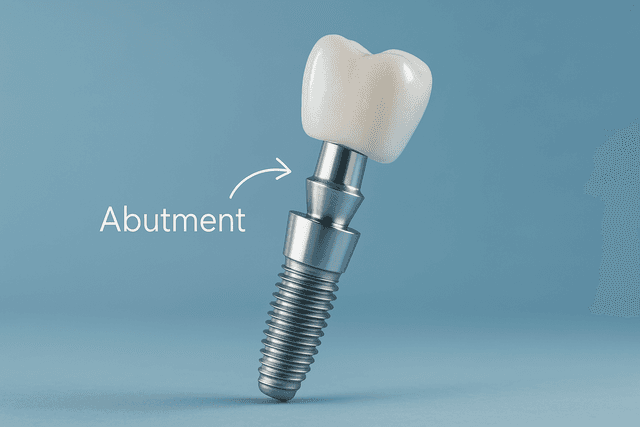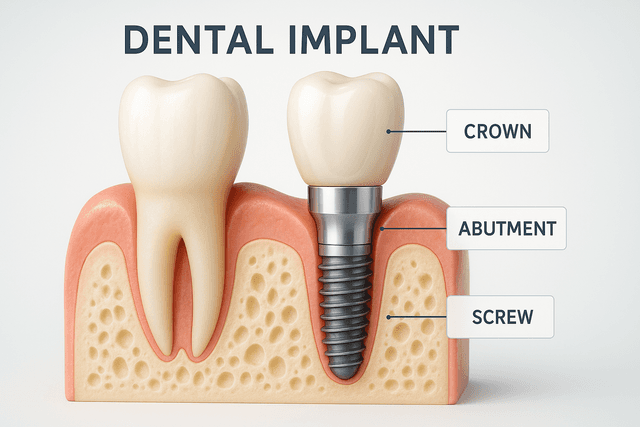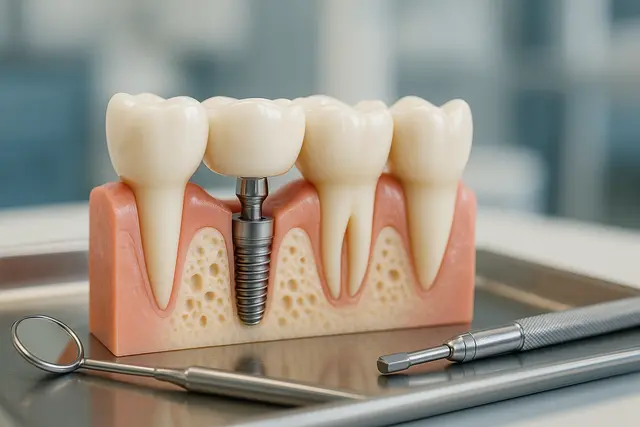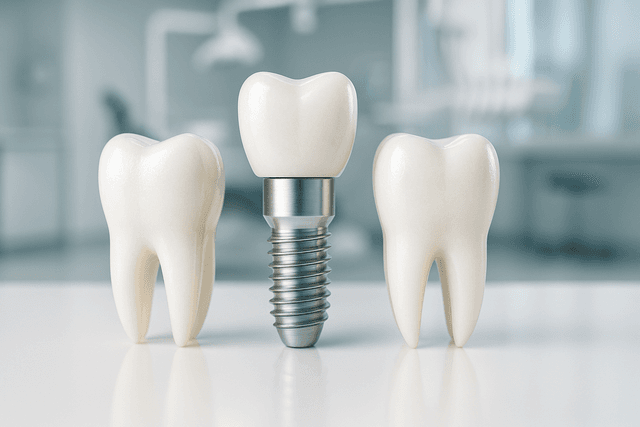Prosthodontics
4 min read
Oct 10, 2025
Implant Abutment Explained: What It Is and Why It Matters
Dental implants have revolutionized the way we restore missing teeth, but there's more to them than just the visible crown. One often-overlooked component, the implant abutment, plays a crucial role in both the function and appearance of the final result. Understanding what it is and why it matters can make all the difference in your implant journey.

So, you’ve heard about dental implants, maybe from your dentist or during one of those late-night rabbit holes on Google. And now this mysterious term keeps popping up: implant abutment. Sounds like something out of a spaceship manual, right? But hang tight. We’re going to break it all down, plain and simple, so you actually understand what this thing is and why your smile might depend on it.
Understanding the Implant and Abutment Connection
Let’s start with the basics. A dental implant is a small titanium post that’s surgically placed into the jawbone. It acts as an artificial tooth root, offering a solid base for your new tooth. But here’s the thing: that implant doesn’t just magically hold a crown (aka your shiny new tooth) on its own.
Enter the abutment. This little hero is a connector piece. It's attached to the implant and it’s what holds the crown in place. Think of it as the middleman between the implant and the crown, making sure everything stays where it should.
An implant without an abutment is like a house without walls, just a lonely foundation. The abutment is part of the dental implant system, and it’s crucial for both function and the aesthetics of the dental implant.
How the Dental Implant Abutment Works
Once the implant is placed into the jawbone and has gone through osseointegration (a fancy way of saying the bone has fused to it), your dentist or oral surgeon will begin the next step of the implant process: placing the abutment.
This usually happens after the healing phase, which can take a few months. But sometimes, depending on the type of implant, the abutment is placed at the same time as the implant. Either way, the goal is the same, connect the implant to the crown.
Now, when the abutment is attached, it sticks out just slightly above the gumline, creating a stable anchor for the crown. If you’re wondering whether this part hurts, relax. The abutment procedure is pretty straightforward and far less invasive than the implant surgery itself.
Different Type of Abutment Options
Not all abutments are created equal. Some are stock pieces, while others are custom abutments made to fit your gumline and match the color and shape of your natural teeth. Custom abutments can make a big difference in the final look and how the crown sits around the gum tissue.
Choosing the right type of abutment depends on your implant and the condition of your gum. Your dentist will go over the best abutment options with you during your treatment plan, making sure you get the best fit for your mouth and your smile.
From Healing Abutments to Final Placement
Before the final abutment is placed, many patients will wear healing abutments or healing caps. These are temporary pieces attached to the implant post that help the gum tissue heal around the implant site. They shape the gumline so the permanent crown looks natural once it’s placed.
Once your gums are ready and everything’s healed, it’s time to swap the healing abutment for the final one and place the permanent crown. This is the part where you really start seeing results, your tooth is back, it looks real, and it feels solid.
Implant Components and What They Actually Do
Let’s do a quick recap of the implant components:
Implant fixture: the titanium post surgically placed into the jawbone.
Abutment: the connector that attaches to the top of the implant.
Crown: the visible part that looks and acts like a natural tooth.
Each component has a job to do, and if one fails, well, it throws everything off. That’s why the abutment helps ensure the stability and success of the entire implant.
Why Abutments Matter for Implant Success
Implant failure can happen for several reasons, but a poorly fitting or loose abutment can be a big culprit. If the abutment screw isn’t properly secured or the gumline doesn’t heal well around the abutment, you could end up with trouble around the implant.
That’s why placing an abutment correctly, and choosing the right one, is a make-or-break moment in implant dentistry.
What About Dentures and Other Prosthetics?
While implants often support individual crowns, they can also be used with dentures and other prosthetic devices. In these cases, the implant abutment still plays the same role: connecting the implant to the prosthesis.
Whether you’re missing teeth from an injury, decay, or bone loss, implants supported by strong abutments can offer a stable, lasting solution. Unlike traditional dentures, they won’t slip, click, or fall out when you’re mid-laugh.
Trusting the Right Dentist for Your Abutment Needs
Not every dentist handles implants, and certainly not every practice handles abutments with the same precision. Working with an experienced dentist or oral surgeon who understands how abutments serve both function and appearance is key.
They’ll evaluate your implant placement, gum health, and even how the crown is attached to ensure your implant procedure goes smoothly and your final result looks amazing.
What Is an Implant Abutment and Why Is It Important?
An implant abutment is the connector piece that joins the dental implant (the titanium post in your jawbone) to the crown, which is the visible artificial tooth. It acts as the bridge between the implant and the restoration, ensuring your new tooth stays stable and functions like a natural one. Without a properly placed abutment, the implant cannot support a crown effectively, making it one of the most critical components of a successful dental implant.
How Is an Implant Abutment Placed?
Once the implant has fully integrated with your jawbone—a process called osseointegration—your dentist or oral surgeon attaches the abutment. This involves exposing the top of the implant and securing the abutment in place, often with a small screw. In some cases, the abutment can be placed during the same procedure as the implant. After placement, a crown is attached to the abutment, completing your restored tooth.
Are There Different Types of Abutments?
Yes, there are two main types: stock abutments and custom abutments. Stock abutments are pre-made and designed to fit standard implant systems, while custom abutments are tailored specifically for your mouth. Custom options are often chosen for better gum contouring, improved aesthetics, and a more precise fit, especially in visible areas like the front teeth. Your dentist will recommend the best choice based on your needs and anatomy.
What Problems Can Occur With Implant Abutments?
The most common issues involve screw loosening, improper fit, or inflammation around the gumline. A poorly fitted abutment can affect both the appearance and stability of your implant. In some cases, it may even lead to infection or implant failure. That’s why it’s crucial to have the abutment placed by a skilled implant dentist who follows correct torque and fitting protocols. Regular dental visits help ensure everything remains secure and healthy.
Read Next
Related Posts

Prosthodontics
Implant Abutment Screw Explained: Function, Types, and Placement
Dental implants have revolutionized the way we restore missing teeth, but beyond the visible crown lies a small yet essential component that ensures everything stays firmly in place: the implant abutment screw. Understanding its function, placement, and types is key to appreciating the science and precision behind a successful implant.
5 min read
Oct 10, 2025

Prosthodontics
Pros and Cons of Implant Retained Bridges: A Simple, Honest Overview
Missing teeth can affect more than just your smile, they can impact your confidence, speech, and even how you eat. With so many options out there, it’s easy to feel lost in dental jargon and marketing buzzwords. That’s why we’re breaking down implant retained bridges in plain English, highlighting the pros and cons so you can make an informed choice without the fluff.
6 min read
Oct 10, 2025

Prosthodontics
Implant Crown Lifespan: What to Expect Over Time
Getting a dental implant crown is a big step toward restoring both function and confidence in your smile. But like any dental work, it's natural to wonder how long it will actually hold up. From materials and maintenance to daily habits, several factors play a role in how long your implant crown will last.
4 min read
Oct 10, 2025
Don’t have time to research every dentist around you?
See why 30k+ patients trusted us